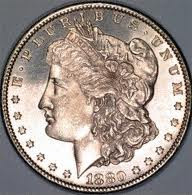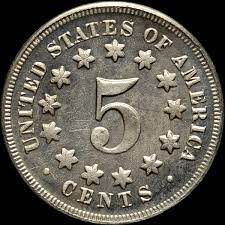This was first posted in 2011 by request from Hannah, who wanted to know what money looked like and what it was worth, like when Andi and Rosa bought ribbon for a dime (Long Ride Home).
Find more Andi’s Journal (and A Blast from the Past) posts in Andi’s Attic >>
January 1881
Coin Gallery
First off, here is a dime, just like the dime I found in my saddlebag in the livery last spring, when I was on the road looking for Taffy. I shared with Rosa so we could buy a ribbon and licorice. That was a really nice surprise since Jose and Nila were running out of beans and cornmeal to make tortillas. One of my dimes bought them a good portion of dry beans.

Later in the book, that mean ol’ Felicity offered to buy Taffy for $20.00. In 1880, a twenty-dollar gold piece was called a “Double Eagle.” Felicity could have given me one of those, but she slapped two “Eagles” in my hand. Each “Eagle” is a ten-dollar gold piece.
Can you guess what a “Half-Eagle” might be? Yep, a five-dollar gold piece. In Andrea Carter and the Price of Truth, Chad paid me eight dollars for all that work I did picking peaches. He gave me a half-eagle and three silver dollars. There were pennies too. Ever heard of penny candy? Nickels were used in 1880, but the silver “half dimes” were used too. Both were worth five cents. See what each coin looked like (and what it was worth) below in this gallery.






Greenbacks (paper money)
I had to give a presentation on how our United States paper money came about. Most of the students rolled their eyes and smirked because nearly everybody knows how it happened. But I glared at them, especially that ol’ Johnny Wilson. When Mr. Foster glared at him too, I knew I could finish without blowing up in annoyance.
“Greenbacks” is the name for paper money in the United States in 1880. Paper money hasn’t been around for very long, only about fifteen years or so. Since the War Between the States (or the War of Northern Aggression for you Southerners in the classroom. Or the Civil War. They’re all names for the same war, back in 1861-1865).
Anyway, before the War, everybody used gold and silver coins to buy and sell things. But they probably got pretty heavy in pocketbooks and purses.
However, the War cost money—a lot of money, and the United States didn’t have enough money from taxes. The Treasury Department decided to issue small rectangles of paper called “demand notes” (payable on demand) to people who lent the government money to pay the soldiers and finance the War. These “demand notes” were printed on green paper. So guess what! Their nickname became “greenbacks.”

After the War, some people wanted to keep the paper money in circulation permanently. But the Secretary of the Treasury said it had only been a War measure. The country must go back to the gold standard: silver and gold coins.
So the government started “retiring” (getting rid of) the paper money. But this caused problems too. The economy was not doing well, and they found an old law that allowed them to put some paper money back in circulation, which they did.
Back and forth the argument went, but as everyone knows, paper money is here to stay.
Thank you for your attention, and I hope I get an A on this report, Mr. Foster.
Note from Mrs. M. During Andi’s later years and her lifetime (1933), private citizens ended up having to trade in all their gold, and the gold standard basically disappeared. Now, in the 21st century, rumors are spreading about doing away with both coins and cash in favor of digital (crypto) transactions. How times change!



That is so interesting. Thanks for sharing Mrs. M! I enjoyed it. And yes, times have changed big time!
LikeLiked by 1 person
Oh, how everything from clothing styles to money changes! And if you go to other countries–even Canada–their money is different from ours.
LikeLiked by 1 person
Super interesting! Thx Mrs. M.
LikeLike
This was so fun to read, thanks! I love seeing and collecting money from various countries, it’s so interesting! My older sister and I have been competing for years to see who can collect coins from the most countries we’ve traveled to, as well as stamps. 🙂
LikeLiked by 1 person